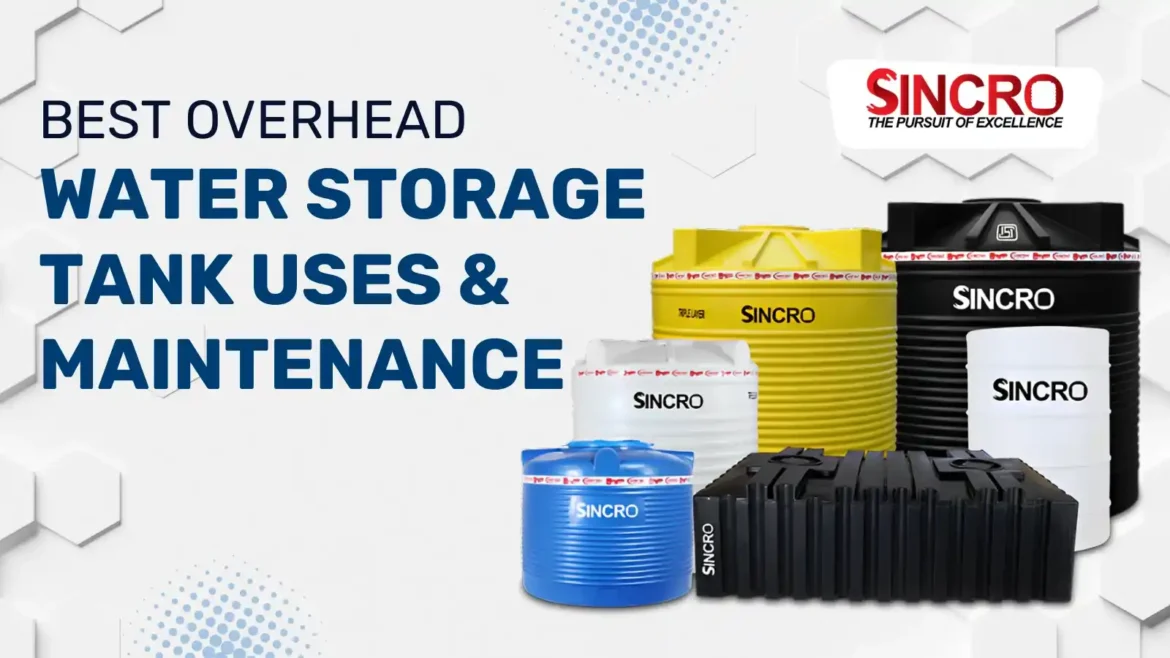A dependable water storage system is a necessity in any home, business, or farm. Within the multitude of options available, the overhead water storage tank provides the most convenience, is most effective, and gravity gravity-fed. But what are the best uses for an overhead tank, and how do you maximise its efficiency? Let’s get into the details.
Why Choose an Overhead Water Storage Tank?
When using an overhead water storage tank, you place the tank at such an elevation, typically on a roofed or platform deck, that the water can flow by gravity to the taps and pipes. The overhead tank allows you to utilise gravity and eliminate the use of electric pumps in dozens of day-to-day situations to bring water to the tap. This can be far more efficient in terms of energy consumption.
Overhead tanks are generally rust-proof, durable, affordable, and made of some of the best quality plastic, like Sincro water tanks. If you are looking for a long-term plastic water tank, an overhead water tank is one of the best practical solutions.
Best Uses of Overhead Water Tanks
1. Domestic Water Supply
For homes, an overhead water tank ensures that you always have water on hand for cooking, cleaning, bathing, and laundry. The elevated position of the tank provides steady water pressure without needing complex plumbing systems.
2. Agricultural Irrigation
On farms, gravity-fed tanks simplify water distribution to crops and greenhouses. This method is not only efficient but also saves on operational costs since it doesn’t require high-powered pumps.
3. Commercial and Industrial Facilities
Businesses and factories need consistent water for restrooms, cooling systems, and processing needs. Overhead water storage tanks can easily meet high-demand scenarios while reducing dependency on the mains water supply.
4. Emergency Backup
An overhead tank doubles as a buffer during water outages. Whether the issue is a power failure or a municipal supply cut, stored water in the tank ensures uninterrupted access.
5. Rainwater Harvesting Systems
Overhead tanks are ideal for storing harvested rainwater. Collected rainwater can be filtered and reused for gardening, flushing, and cleaning, making it an eco-friendly choice.
Key Maintenance Tips for Overhead Water Tanks
An overhead water storage tank, like any utility asset, needs regular upkeep. Here’s how to keep it clean and functioning optimally:
1. Schedule Regular Cleaning
Over time, silt and biofilm can accumulate inside the tank. It’s recommended to clean your tank every six months. Drain it fully, scrub the interior with a soft brush, and rinse thoroughly. Avoid using harsh chemicals that could leave residues.
2. Inspect for Cracks and Leaks
Even the best plastic water tank can wear out over time. Regularly inspect your tank for cracks, loose fittings, or leaks. Catching issues early can prevent water loss and structural damage.
3. Use a Tank Cover
Always keep your overhead tank covered. This prevents debris, insects, and animals from entering the water supply and reduces algae growth caused by sunlight.
4. Install a First Flush Diverter for Rainwater
If you’re using the tank for rainwater harvesting, install a first flush system to divert the initial runoff, often filled with contaminants, away from the tank.
5. Check Inlet and Outlet Pipes
Make sure all connected pipes are free from blockages and properly sealed. Water inflow and outflow should be smooth, without leaks or unusual noises.
6. Avoid Overfilling
An automatic float valve can prevent overflows. Overfilling not only wastes water but can also damage the tank structure over time.
Why Choose Sincro?
When it comes to water storage solutions you can trust, look no further than the Sincro water tank. Sincro has a solid reputation for quality and innovation, and they make a full range of overhead, vertical, and loft water storage tanks to suit any water storage task.
Some of the key features of Sincro water tanks include:
- Durable food-grade plastic
- UV-resistant material
- Multiple capacities available
- Quick installation
- Full customer support
From houses to high-rise buildings, from factories to farms, Sincro water tanks offer top performance. Whether you need a vertical water tank for outdoor use or a compact loft water tank for indoor installation, Sincro has the best match for your project.
Conclusion
A good overhead water storage tank is more than just a tank; it’s an indispensable part of everyday convenience. It allows water to be delivered to where you want it, when you want it, and it can decrease reliance on utility services and can even allow for sustainable practices like rainwater harvesting.
Working with a trusted water storage tank supplier like Sincro means you can invest knowing you are dealing with efficiency, longevity, and peace of mind. Think Sincro for reliable, low-maintenance plastic water tanks in the long term.
Frequently Asked Questions
1. Which water storage tank is best?
Which water storage tank is the best for you will ultimately depend on your particular applications, but high-quality plastic (high-density polyethylene-HDPE), stainless steel and concrete tanks are wisely chosen for their durability, safety, and cost-effective options. For homes, UV-stabilised plastic water tanks are usually the most preferred tanks.
2. How do you maintain a water storage tank?
Perform tank cleanings every 6 months. Check for cracks and leaks, and ensure the tank lid is secured properly. Sometimes, a water purifier will be useful with chlorine or other water treatment to help keep the tank fresh and uncontaminated.
3. What is the lifespan of the overhead tank?
An overhead tank’s durability is tied to the material of the tank, because plastic tanks last only 10–15 years, but concrete or steel tanks can last more than 25 years with maintenance and protection from the elements.
4. What is the use of an overhead water tank?
An overhead water tank contains drinking water at a height. Therefore, water pressure is constant during household or industrial use. The water is supplied to taps, toilets, and appliances through gravity-fed distribution.







